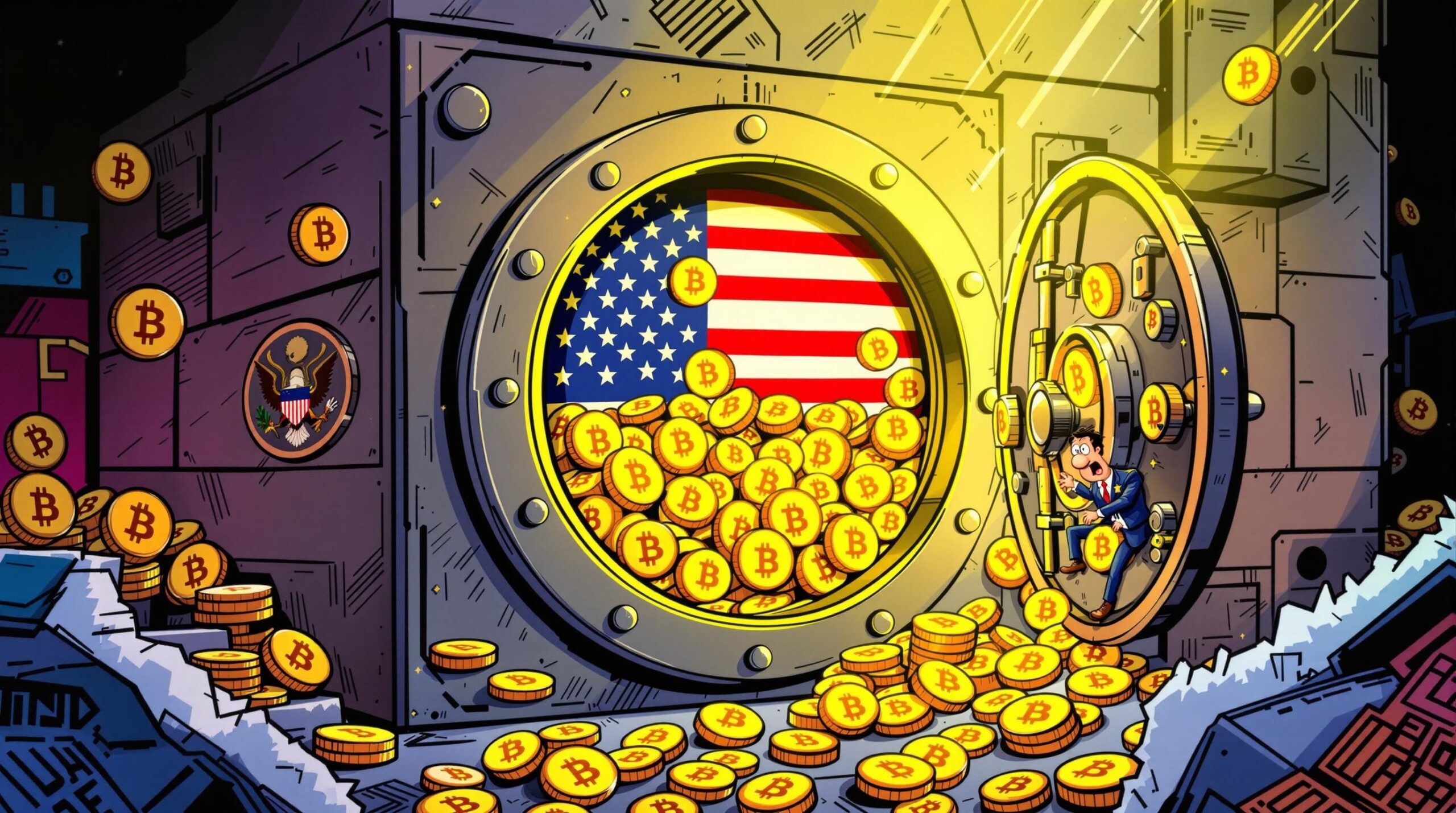BitcoinWorld

US Government Bitcoin: Unveiling the Staggering $23.5 Billion Stash’s Four-Month Freeze
The world of cryptocurrency is often characterized by rapid movements and constant shifts. Yet, amidst this dynamic landscape, one significant player has remained remarkably static: the US government Bitcoin holdings. For four consecutive months, an estimated 198,000 BTC, currently valued at a staggering $23.5 billion, has sat undisturbed across various government wallets. This fascinating stability, highlighted by data from Arkham on X, prompts a deeper dive into the implications of such a colossal, yet inactive, digital asset portfolio.
Unpacking the US Government Bitcoin Stash: A Closer Look at the $23.5 Billion Mystery
The sheer scale of the US government Bitcoin reserves is truly remarkable. Comprising almost 200,000 BTC, this digital treasure chest is not concentrated in a single wallet but is distributed among several key federal agencies. These holdings primarily originate from seizures related to criminal activities, ranging from drug trafficking to cybercrime and money laundering operations. The process of acquiring and managing these assets involves complex legal procedures and inter-agency coordination.
According to insights shared by Arkham, the primary custodians of this immense wealth include:
- Department of Justice (DOJ): Often involved in high-profile seizures from major criminal enterprises.
- Federal Bureau of Investigation (FBI): Frequently at the forefront of cybercrime investigations leading to digital asset confiscations.
- Drug Enforcement Administration (DEA): Targets illicit drug operations that often utilize cryptocurrencies for transactions.
- U.S. Marshals Service (USMS): Responsible for managing and ultimately liquidating seized assets, including cryptocurrencies.
It is important to note, as Arkham pointed out, that the publicly disclosed 28,988 BTC by the USMS represents only a fraction of the government’s total digital asset holdings. This suggests a significant portion remains under the direct control or oversight of other agencies, or is simply not publicly detailed, adding a layer of intrigue to the situation. The consistent non-movement of these funds raises questions about the government’s strategy and future plans regarding these substantial assets.
Why Has the US Government Bitcoin Stash Remained Untouched for Four Months?
The prolonged dormancy of such a significant crypto hoard is not without potential explanations. Unlike private investors who might actively trade or stake their assets, government entities operate under different protocols and constraints. Several factors could contribute to this extended period of inactivity:
- Legal and Custodial Processes: Seized assets, especially those involved in ongoing legal cases, are often held in secure custody until final court orders or appeals are resolved. This can be a lengthy process, preventing any immediate liquidation or movement.
- Market Conditions Assessment: Governments, like large institutional investors, may be assessing market conditions. Given the volatility of Bitcoin, a decision to hold could be strategic, awaiting more favorable market conditions for potential liquidation to maximize recovery value.
- Policy Development: The U.S. government is still in the nascent stages of developing comprehensive policies for managing digital assets. There might be internal discussions, policy reviews, or legislative considerations underway that dictate a ‘wait and see’ approach before making significant moves.
- Operational Logistics: Moving such large quantities of Bitcoin requires robust security protocols, internal approvals, and technical infrastructure. The logistics involved in preparing for a potential sale or transfer can be complex and time-consuming.
This period of inaction might signal a cautious, methodical approach rather than a lack of interest or awareness. It underscores the unique challenges and considerations governments face when managing assets like Bitcoin, which blur the lines between traditional financial instruments and novel digital commodities.
The Enormous Scale of US Government Bitcoin Holdings: A Global Perspective
To truly grasp the magnitude of the US government Bitcoin holdings, it helps to put them into context. With 198,000 BTC, the U.S. government ranks among the largest known single holders of Bitcoin globally, surpassing many publicly traded companies and even some nation-states that have adopted Bitcoin as a reserve asset.
Consider the following comparison points (values are approximate and subject to change):
| Entity | Approximate BTC Holdings | Notes |
|---|---|---|
| U.S. Government | ~198,000 BTC | Seized assets, across multiple agencies. |
| MicroStrategy | ~226,000 BTC | Publicly traded company, corporate treasury strategy. |
| Block.one | ~140,000 BTC | Private company, software development. |
| Tesla | ~9,720 BTC | Publicly traded company, reduced holdings from peak. |
| El Salvador | ~5,700 BTC | Nation-state, adopted Bitcoin as legal tender. |
The potential impact of any future movement or liquidation of these holdings on the broader crypto market cannot be overstated. A large, sudden sale could introduce significant selling pressure, while a decision to hold long-term could signal a quiet, underlying confidence in Bitcoin’s value by a powerful global entity. This makes the inactivity of the US government Bitcoin a subject of keen interest for market analysts and investors alike.
What Are the Implications of the US Government Bitcoin Policy?
The current ‘hold’ strategy, whether intentional or incidental, carries several implications for the crypto ecosystem and the broader financial world:
Challenges:
- Transparency Concerns: The lack of granular, real-time public disclosure on all government crypto wallets can lead to speculation and uncertainty within the market.
- Market Volatility Risk: While currently static, the sheer volume of these holdings means any future, sudden liquidation could significantly impact Bitcoin’s price, creating market instability.
- Public Perception: The perception of the government holding onto vast amounts of seized crypto assets without a clear, public strategy can raise questions about efficiency and accountability.
Benefits (from a government perspective):
- Asset Recovery: The ability to seize and hold digital assets ensures that proceeds from illegal activities are recovered and can be used for public benefit or victim compensation.
- Potential Future Revenue: By holding, the government retains the potential for significant appreciation in value, which could translate into substantial funds for various government initiatives if eventually sold at a higher price.
- Deterrence: The successful seizure and retention of such large amounts of crypto sends a clear message to criminals that digital assets are not immune from law enforcement actions.
Actionable Insights for Investors:
- Monitor On-Chain Data: Tools like Arkham provide valuable insights. Keeping an eye on known government wallets can offer early warnings of potential movements.
- Understand Market Dynamics: Recognize that large institutional or governmental movements can influence market sentiment and price. Factor this into your risk assessment.
- Stay Informed on Policy: As governments globally continue to grapple with crypto regulation, policy changes could directly impact how these seized assets are managed and potentially liquidated.
The non-movement of the US government Bitcoin holdings is a quiet but powerful indicator of the evolving relationship between traditional governance and decentralized finance. It highlights both the challenges of integrating novel assets into existing legal frameworks and the potential for governments to become significant, albeit often passive, players in the crypto market.
The U.S. government’s decision, or perhaps procedural necessity, to keep its vast US government Bitcoin holdings untouched for four months offers a unique case study in the intersection of digital assets and state power. With an estimated 198,000 BTC, valued at an astonishing $23.5 billion, this dormant treasure chest represents a significant, yet largely unutilized, force within the global crypto economy. Whether this prolonged inactivity is due to complex legal processes, strategic market timing, or ongoing policy formulation, its implications are profound. It underscores the growing importance of Bitcoin as a seized asset and a potential future revenue stream for governments, while simultaneously posing questions about transparency and potential market impact. As the digital asset landscape continues to mature, all eyes will remain on these colossal government holdings, awaiting their next, potentially market-moving, action.
Frequently Asked Questions (FAQs)
Q1: How much Bitcoin does the US government currently hold?
A: The U.S. government is estimated to hold approximately 198,000 BTC, valued at around $23.5 billion (as of recent market valuations).
Q2: Which US government agencies are involved in holding this Bitcoin?
A: Key agencies include the Department of Justice (DOJ), Federal Bureau of Investigation (FBI), Drug Enforcement Administration (DEA), and U.S. Marshals Service (USMS).
Q3: Why hasn’t the US government moved its Bitcoin holdings for four months?
A: Reasons likely include ongoing legal processes for seized assets, strategic market assessment, the development of comprehensive digital asset policies, and complex operational logistics for managing such large quantities.
Q4: What is the primary source of the US government’s Bitcoin holdings?
A: The vast majority of the U.S. government’s Bitcoin holdings come from seizures related to criminal activities such as drug trafficking, cybercrime, and money laundering.
Q5: What would be the potential impact if the US government decided to sell its Bitcoin?
A: A large, sudden sale of the U.S. government’s substantial Bitcoin holdings could introduce significant selling pressure into the market, potentially leading to a notable decrease in Bitcoin’s price due to increased supply.
Q6: Does the US government actively trade or manage its Bitcoin portfolio?
A: While the U.S. government does liquidate seized assets periodically, its approach to Bitcoin is generally more reactive (seizure and eventual sale) than proactive trading. The current four-month period of inactivity suggests a hold strategy for these specific funds.
If you found this article insightful, consider sharing it with your network! Your support helps us continue to provide valuable insights into the evolving world of cryptocurrency. Share on Twitter, Facebook, or LinkedIn to spark a conversation!
To learn more about the latest crypto market trends, explore our article on key developments shaping Bitcoin institutional adoption.
This post US Government Bitcoin: Unveiling the Staggering $23.5 Billion Stash’s Four-Month Freeze first appeared on BitcoinWorld and is written by Editorial Team





